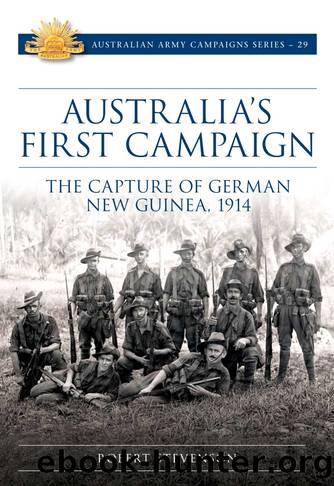Australia's First Campaign by Robert Stevenson

Author:Robert Stevenson
Language: eng
Format: epub
ISBN: 9781922387721
Publisher: Big Sky Publishing
The rendezvous of the Australian Squadron off Rossel Island on 9 September 1914. The conference aboard Australia was the first opportunity for Patey and Holmes to discuss their task face-to-face. This photograph, taken from Encounter, shows (left to right): Sydney (partially obscured), Berrima, Aorangi and Australia (partially obscured) (AWM H12595).
Patey, with Australia and the colliers Waihora and Whangape, rendezvoused as planned with Glossop on 9 September. Pateyâs command now represented almost the entire fighting strength of the RAN. If it possessed one significant deficiency, it was the lack of dedicated mine warfare vessels. If the Germans deployed mines in the sheltered waters of Simpson Harbour these would have to be swept as best they could by picket boats from Australia, a risky undertaking for any unarmoured vessel. The difficulties of such a task could not be dismissed as the Allies would soon discover when the British and French fleets attempted to force the Dardanelles in March 1915. Only in 1917, in response to the sinking of three merchant ships by German-laid mines in home waters, did the RAN form a minesweeping squadron.
After leaving Samoa, Patey had temporarily detached Melbourne on a preliminary operation to destroy the German radio station at Nauru. The RAN warship reported on 9 September that the station had been disabled by its staff and the island surrendered without opposition. As Melbourne completed its task, the fleet and ANMEF commanders had their first opportunity to discuss the task ahead face-to-face.
At Rossel Island Patey convened a meeting aboard Australia with Holmes, Glossop and Stevenson in what was Australiaâs first high-level joint conference on active service. The Admiral explained to the assembled officers that his orders provided for the occupation and garrisoning of Kokopo and Rabaul, which he aimed to effect on 11 September. He also made it clear that he expected the landings to be a repeat of his August affair and he did not anticipate any resistance ashore.
Holmes then briefed the Admiral and others on his plan of occupation, which was likewise based on a belief that there would be no German resistance. His intention was to employ Watsonâs battalion to garrison Rabaul, leaving Kokopo to Beresford and the Naval Battalion. As a preliminary operation to the main landings, two small naval parties were to be put ashore to search for the two suspected radio stations, one six kilometres inland from Kokopo and the other eight kilometres inland from Kabakaul, a small village seven kilometres east of Kokopo. Neither commander really knew what the men might face ashore because there was little hard intelligence on their objective, aside from recent information collected at Port Moresby on the disposition of the suspected radio sites. As the Australian Official History suggests, part of German New Guineaâs defence in 1914 was its âunknownnessâ.
Download
This site does not store any files on its server. We only index and link to content provided by other sites. Please contact the content providers to delete copyright contents if any and email us, we'll remove relevant links or contents immediately.
| Africa | Americas |
| Arctic & Antarctica | Asia |
| Australia & Oceania | Europe |
| Middle East | Russia |
| United States | World |
| Ancient Civilizations | Military |
| Historical Study & Educational Resources |
Magic and Divination in Early Islam by Emilie Savage-Smith;(1516)
Bohemians, Bootleggers, Flappers, and Swells: The Best of Early Vanity Fair by Bohemians Bootleggers Flappers & Swells- The Best of Early Vanity Fair (epub)(1369)
Ambition and Desire: The Dangerous Life of Josephine Bonaparte by Kate Williams(1366)
Papillon by Henry Charrière(1357)
Twelve Caesars by Mary Beard(1296)
Operation Vengeance: The Astonishing Aerial Ambush That Changed World War II by Dan Hampton(1148)
What Really Happened: The Death of Hitler by Robert J. Hutchinson(1142)
London in the Twentieth Century by Jerry White(1125)
Time of the Magicians by Wolfram Eilenberger(1112)
The Japanese by Christopher Harding(1108)
Twilight of the Gods by Ian W. Toll(1104)
Lenin: A Biography by Robert Service(1063)
The Devil You Know by Charles M. Blow(1005)
A Social History of the Media by Peter Burke & Peter Burke(961)
Freemasons for Dummies by Hodapp Christopher;(946)
Napolean Hill Collection by Napoleon Hill(918)
Henry III by David Carpenter;(905)
The Churchill Complex by Ian Buruma(893)
The Rise and Triumph of the Modern Self by Unknown(893)
